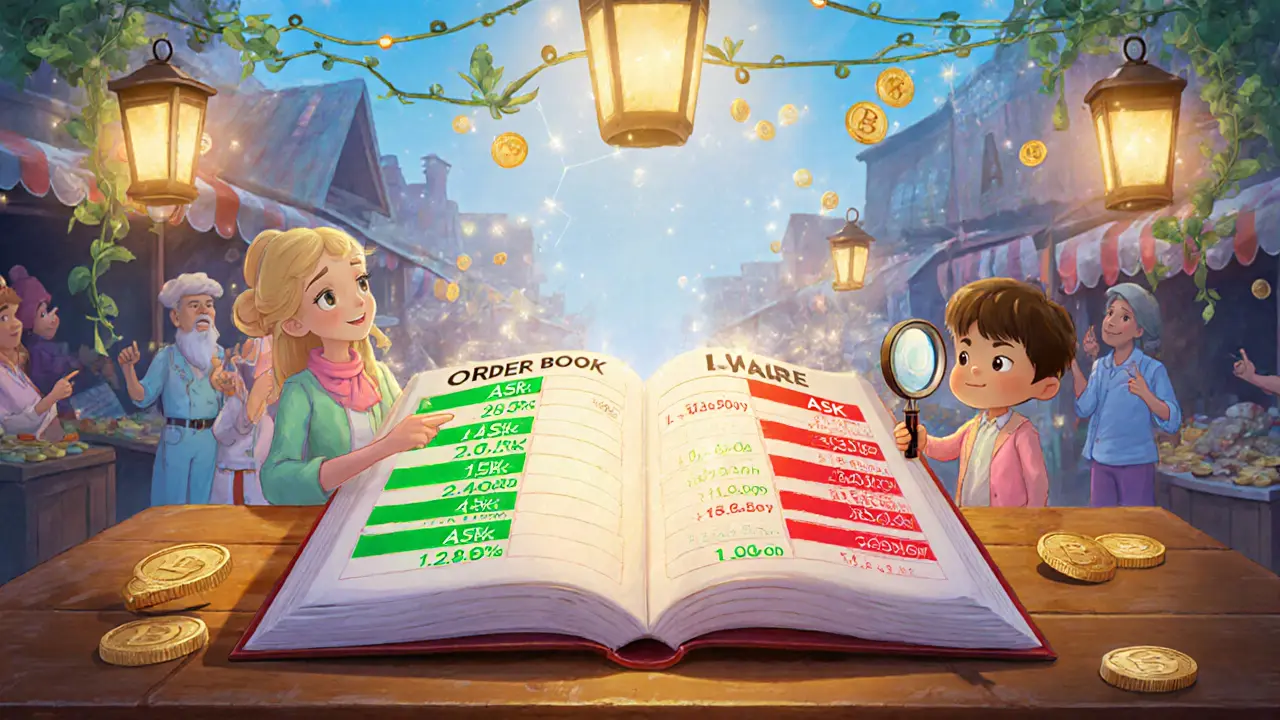Posted By Tristan Valehart On 15 Feb 2025 Comments (22)

Cryptocurrency Order Book Simulator
Bids (Buy Orders)
Asks (Sell Orders)
How to Read This Order Book
Bid Side (Green): Shows buy orders at different prices. Higher bids are at the top.
Ask Side (Red): Shows sell orders at different prices. Lower asks are at the bottom.
Bid-Ask Spread: Difference between the highest bid and lowest ask. Narrow spread = better liquidity.
Try changing the trading pair to see different liquidity patterns.
Ever wondered why a crypto price can jump from $99,800 to $99,850 in seconds? The backstage crew behind that move is the cryptocurrency order book. It’s the live ledger that shows every pending buy and sell request for a trading pair, letting traders see real‑time supply and demand. If you can read the order book, you can anticipate price shifts, spot liquidity traps, and place smarter orders.
What Exactly Is an Order Book?
Order Book is a real‑time digital list of all outstanding buy (bid) and sell (ask) orders for a specific cryptocurrency pair on an exchange. Each line records three things: the price level, the amount of crypto offered at that price, and a timestamp showing when the order entered the system. The list lives on every centralized exchange - Binance, Coinbase Pro, Kraken - and refreshes thousands of times per second as traders add, modify, or cancel orders.
How the Order Book Is Structured
The order book splits into two sides:
- Bid side - green numbers showing how much buyers are willing to pay. The highest bid sits at the top.
- Ask side - red numbers showing how low sellers are ready to go. The lowest ask sits at the bottom.
The gap between the top‑most bid and the bottom‑most ask is the Bid‑Ask Spread, a quick gauge of market liquidity and trading cost. A narrow spread (e.g., $0.02 on BTC/USDT) means deep liquidity; a wide spread (e.g., $5 on a thin‑traded altcoin) signals higher slippage risk.
Centralized vs. Decentralized Order Books
Not all crypto platforms use the same order‑book model. The two big camps are:
| Feature | Centralized Exchange (CEX) Order Book | Decentralized Exchange (DEX) - AMM Model |
|---|---|---|
| Liquidity Source | Aggregated from user orders & market makers | Liquidity pools provided by users (smart contracts) |
| Price Discovery | Visible depth, bid‑ask spread, order‑matching engine | Automated curve (no visible order depth) |
| Execution Speed | Sub‑millisecond matching on high‑performance servers | On‑chain transaction latency (seconds to minutes) |
| Regulation & Custody | Custodial, KYC/AML compliant | Non‑custodial, pseudonymous |
| Typical User | Professional traders, institutions, high‑frequency bots | DeFi participants, yield farmers, casual traders |
Hybrid platforms are emerging that blend on‑chain order books with AMM pools, but the classic CEX order book still dominates professional crypto trading.

Reading the Order Book: Market Depth, Liquidity, and Walls
When you open the order‑book view on Binance, you’ll see stacks of numbers. Here’s what to look for:
- Market Depth - total volume available at each price tier. A deep market can absorb big orders without moving the price much.
- Liquidity - the ease of turning crypto into cash without slippage. High depth on both sides equals high liquidity.
- Buy wall - a large cluster of bids at a specific price, often acting as support.
- Sell wall - a large cluster of asks, often acting as resistance.
Traders use walls to gauge where price might bounce or stall. However, walls can be fake: a bot places a huge order to scare others, then cancels it instantly - a practice called Spoofing.
Common Pitfalls: Spoofing, Slippage, and False Signals
Even seasoned traders get tripped up:
- Spurious walls - If a wall disappears after a few seconds, it was likely a spoof. Relying on it for entry can cause a rapid price swing.
- Slippage - When you submit a market order larger than the visible depth, the order “walks” through multiple price levels, ending at a worse rate.
- Over‑reacting to tiny updates - Order books refresh dozens of times per second. A single order that pops up and disappears may not reflect genuine supply.
Mitigation strategies include using limit orders, monitoring order‑book changes over a short window (e.g., 5‑second average), and combining order‑book data with on‑chain volume metrics.
Practical Tips for Using the Order Book Effectively
Here’s a checklist you can follow the next time you trade:
- Start with a small position to feel how quickly the book moves on your chosen pair.
- Identify the mid‑price (average of best bid and best ask) and watch how it reacts when large orders hit either side.
- Look for a consistent buy wall that has held for at least a few minutes; that’s a more reliable support level.
- Set limit orders a few ticks below a sturdy buy wall or above a strong sell wall to catch breakouts.
- Use the exchange’s “order‑book depth” view (often a heat map) to spot rapid changes in volume.
- Combine order‑book signals with technical analysis (candlestick patterns, volume spikes) for confirmation.
Most exchanges, including Binance Academy and Coinbase Learn, provide demo mode or sandbox accounts. Practice there before committing real capital.
Future Trends: AI, Cross‑Chain Order Books, and Faster Matching
Order‑book technology is evolving fast. By 2025, several trends are reshaping how traders interact with depth data:
- AI‑driven order‑flow analysis - Machine‑learning models sift through millions of lines per second to highlight abnormal clusters that may signal manipulation.
- Cross‑chain order books - Some platforms are building unified books that aggregate liquidity from multiple blockchains, allowing you to trade BTC/ETH against a single depth view.
- Sub‑millisecond matching engines - New C++/Rust engines push latency below 1ms, giving high‑frequency traders an edge.
- Regulatory dashboards - Exchanges are adding compliance overlays that flag suspicious order patterns in real time.
These upgrades won’t replace the core concept - a list of bids and asks - but they’ll make the list richer, faster, and harder to game.

Frequently Asked Questions
What does a “liquidity pool” have to do with an order book?
A liquidity pool is the backbone of a decentralized exchange’s AMM model. Unlike a traditional order book, there are no visible bids or asks; instead, a smart contract uses a pricing formula (e.g., constant product) to determine price based on the ratio of assets in the pool. The pool provides instant swaps, but it hides the depth that an order book shows.
How can I spot a spoofing attempt?
Look for a huge order that appears on one side of the book and disappears within a few seconds, especially during low‑volume periods. If the price moves away from that level after the order vanishes, it was likely a fake wall meant to trigger panic.
Why does the spread widen on weekends?
Weekend trading sees fewer professional market makers on‑line, reducing depth on both sides. With less competition to fill orders, the best bid and best ask drift apart, creating a wider spread and higher slippage risk.
Should I use market orders or limit orders when the book is thin?
In a thin market, market orders can easily eat through the visible depth, causing severe slippage. Limit orders placed just outside the current best price give you control over execution price, even if it means waiting a bit longer.
Can I rely solely on the order book for trading decisions?
The order book is a powerful tool, but it’s not infallible. Combine it with on‑chain metrics, macro news, and technical analysis to avoid being misled by temporary spikes or spoofed walls.


Marie Salcedo
February 15, 2025 AT 20:07Great overview! The way you break down the bid and ask sides makes it easy for newcomers. I especially like the tip about watching for order walls as support or resistance. Keep the examples simple and the visuals clear, it really helps. Looking forward to more deep dives like this.
dennis shiner
February 16, 2025 AT 10:00Oh wow, another crystal‑clear order‑book primer, just what my weekend needed. :)
Mangal Chauhan
February 16, 2025 AT 23:54Thank you for the comprehensive walk‑through; it truly bridges the gap between theory and practice. 🙏 The distinction between CEX order books and DEX AMM models is pivotal for anyone venturing into decentralized finance. Your illustration of market depth and liquidity walls adds valuable context. 📊 By emphasizing the role of spoofing, you alert traders to a common pitfall. The inclusion of a sandbox suggestion encourages safe experimentation. I hope more platforms adopt such educational resources. 😊
Darius Needham
February 17, 2025 AT 13:47That section on buy and sell walls hits the nail on the head. Traders often overlook how a persistent wall can act as a magnet for price action. Your assertion that walls can be fake is a crucial reminder. Monitoring order‑book changes over a short window can filter out the noise. Keep pushing these insights.
karyn brown
February 18, 2025 AT 03:40Yo, this is lit! I love how you made the whole order book thing sound like a video game level. Those red ask bars and green bid bars are sooo eye‑catching. Just watch out for those sneaky spoof bots, they can mess up your vibe. Nice job!!
Megan King
February 18, 2025 AT 17:34i think this is super helpful for beginners.
Rachel Kasdin
February 19, 2025 AT 07:27The US exchanges still lead the pack when it comes to deep order books. No other country matches the liquidity you see on Binance or Coinbase. That’s why we should keep supporting home‑grown platforms.
karsten wall
February 19, 2025 AT 21:20Order‑book dynamics constitute the micro‑structure of price formation, a phenomenon that transcends mere bid‑ask spreads. By aggregating limit orders, exchanges instantiate a lattice of supply and demand that algorithms exploit. The concept of market depth operates as a liquidity gradient, influencing execution risk. When a wall emerges, it serves as a quasi‑equilibrium barrier, reminiscent of thermodynamic phase transitions. Spoofing, in this context, is an adversarial perturbation of the order flow. Evaluating the order‑book latency unveils the latency arbitrage opportunities inherent in high‑frequency trading. Ultimately, the order book is a real‑time ledger that encodes collective trader intent, a decentralized consensus on price.
Keith Cotterill
February 20, 2025 AT 11:14In observing the presented material, one cannot help but note the elegance of its structure; indeed, the exposition is a veritable symphony of financial insight, meticulously arranged, and profoundly informative. The juxtaposition of CEX and DEX paradigms, while seemingly elementary, reveals layers of complexity that demand careful contemplation. Moreover, the discussion of liquidity walls-those formidable fortifications of market depth-offers a nuanced perspective rarely found in superficial tutorials. One must, therefore, commend the author for venturing beyond the pedestrian and embracing a more sophisticated discourse. In sum, this is a commendable contribution to the corpus of crypto education.
Noel Lees
February 21, 2025 AT 01:07Nice breakdown, I’m actually going to try the simulator tonight. :)
Adeoye Emmanuel
February 21, 2025 AT 15:00The order book, at its core, is a live snapshot of market intent, aggregating every pending bid and ask into a structured ledger that updates thousands of times per second. Each line in this ledger represents a price level, a quantity, and a timestamp, forming the foundation upon which price discovery unfolds. When a trader places a market order, the matching engine sweeps through the visible depth, consuming liquidity until the order is fully executed, often revealing the true market price in the process. Conversely, limit orders sit patiently on the book, waiting for counterparties to meet their specified price, thereby shaping the future trajectory of the market. The spread between the highest bid and lowest ask serves as an instant barometer of liquidity; a narrow spread indicates a healthy, competitive market, while a wide spread warns of potential slippage and volatility. Order walls-large clusters of bids or asks-function as psychological and technical barriers, frequently acting as support or resistance zones that traders monitor closely. However, these walls are not immutable; sophisticated actors can place massive orders only to cancel them seconds later, a tactic known as spoofing, designed to manipulate market perception. Detecting spoofing requires vigilant observation of order book dynamics, looking for abrupt appearances and disappearances of sizable orders. Moreover, the depth of the book can differ dramatically across exchanges and trading pairs; major pairs like BTC/USDT enjoy deep order books, whereas niche altcoins often suffer from thin liquidity and erratic spreads. Traders must adapt their order strategies accordingly, favoring limit orders in thin markets to mitigate slippage, and possibly employing iceberg orders to conceal large positions. The evolution of order book technology continues unabated, with emerging AI‑driven analytics capable of parsing millions of order updates in real time to flag anomalous activity. Cross‑chain order books are also on the horizon, promising aggregated liquidity from multiple blockchains into a single depth view, further democratizing access. As latency shrinks with sub‑millisecond matching engines, high‑frequency traders gain ever‑more precise execution, sharpening the competitive edge of those with superior infrastructure. Regulatory bodies are increasingly scrutinizing order flow, deploying dashboards that flag suspicious patterns to enforce market integrity. Ultimately, mastering the order book equips traders with a decisive advantage, allowing them to anticipate price movements, manage risk, and execute strategies with informed confidence.
CJ Williams
February 22, 2025 AT 04:54Absolutely insightful! Your deep dive captures the essence of order‑book mechanics perfectly-well done! 🙌
Kamva Ndamase
February 22, 2025 AT 18:47Yo, order walls are like the fortress walls of a medieval battle-break ’em and you get the loot! If you see a massive sell wall, think resistance, hop over it with a bull run. Got my eyes on those green buy walls for next entry. Let’s ride the wave! 🔥
bhavin thakkar
February 23, 2025 AT 08:40The order book is the battlefield where legends are forged.
Thiago Rafael
February 23, 2025 AT 22:34While the exposition is thorough, it would benefit from a more rigorous delineation between centralized and decentralized mechanisms. The current narrative glosses over the nuanced regulatory implications inherent in custodial platforms. Additionally, a quantitative comparison of spread variance across major exchanges could enhance empirical grounding. I recommend integrating these aspects in future revisions.
Janelle Hansford
February 24, 2025 AT 12:27Loved the practical tips section-especially the suggestion to start small and feel the book’s movement. Setting limit orders near sturdy walls is a smart way to catch breakouts without chasing the price. The heat‑map recommendation adds a visual layer that many traders overlook. Keep the hands‑on guides coming!
Krystine Kruchten
February 25, 2025 AT 02:20I'm glad you found it useful! Keep practicing and you'll get the hang of spotting those walls.
Iva Djukić
February 25, 2025 AT 16:14From a theoretical standpoint, the order book serves as a deterministic matrix encoding the collective valuation vectors of market participants, effectively operating as a high‑frequency auction mechanism. Its bid‑ask lattice not only reflects instantaneous supply‑demand equilibria but also encapsulates stochastic anticipations of future price trajectories. By integrating order‑flow analytics with macro‑level sentiment indices, one can construct a multi‑dimensional risk model that surpasses traditional technical analysis. The prevalence of algorithmic strategies introduces a feedback loop, wherein order book perturbations influence subsequent order placement, thereby engendering emergent market dynamics. Moreover, the delineation between liquidity provision via maker orders and taker execution underscores the asymmetry inherent in transaction cost structures. In practice, the strategic placement of limit orders near identifiable walls can serve as a hedging mechanism against abrupt market swings. The evolution toward cross‑chain aggregators promises to homogenize liquidity fragments, fostering a more coherent market microstructure. Consequently, a nuanced comprehension of order‑book topology is indispensable for any sophisticated trader.
carol williams
February 26, 2025 AT 06:07The drama of watching a wall crumble in real time is nothing short of theatrical. It reminds us that markets are alive, breathing entities that respond to human psychology. This article captures that essence admirably.
Maggie Ruland
February 26, 2025 AT 20:00Because we all needed another lecture on order books, right?
Eugene Myazin
February 27, 2025 AT 09:54Awesome write‑up! I appreciate how you included the weekend spread widening tip-very practical for traders worldwide. The blend of technical depth and easy‑to‑follow examples makes this a go‑to reference. Looking forward to more content like this.
Latoya Jackman
February 27, 2025 AT 23:47I find the information useful.